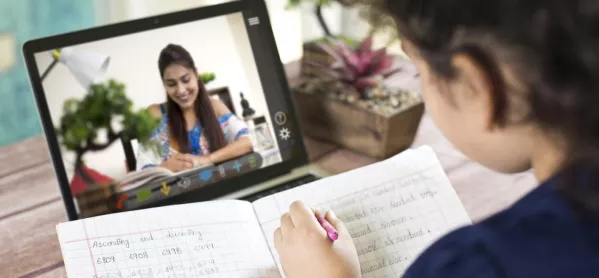9 low-tech online learning plenaries

In the scramble to start your online lesson, look presentable on screen, juggle three windows, and use every superpower you have to manage the behaviour of 30 children several miles away, it’s easy to run out of steam by the end.
Online learning: How to end lessons on a high
But your remote learning lessons can end on a high. Here are a selection of activities to finish your lessons with a flourish:
1. Challenge your teacher
Risky but extremely effective for engagement. Pupils can pitch any question on today’s topic or from today’s discussion, and you have to know the answer. It works best if you prime them at the start of the lesson so they are listening out for nuggets of interest.
2. Word wall
Shamelessly borrowed from the TV quiz show Only Connect. You show a grid with 16 words in it. They can be sorted into four groups of four, but some could conceivably be in two groups. This requires concentration but works especially well as a challenge against the clock.
3. Odd one out
A series of statements, images or examples based on today’s lesson, and one is the odd one out. It might be false when the rest are true, or from the wrong decade, or some other kind of wrong. Not telling pupils what they are looking for will hopefully provoke greater concentration and thought rather than a guess.
4. Going, going, gone
Pupils sum up the main points of the lesson in a sentence, then three words, then one word. This method works nicely as a bookend, where the next lesson in your sequence can begin with a starter giving them back one word, and asking for three words and a sentence to expand on that key knowledge.
5. Real people, real uses
Give your students a brief biography of an achiever in your field and ask them to identify where today’s knowledge would have been useful in their career achievements.
6. Traffic lights
Display a simple traffic light graphic, and ask your class to write a phrase next to each. Green is a concept they understand fully, amber is a question they would like to ask and red is something they have found more challenging or confusing. If they can show these to you, you have a super starting point for your next lesson.
Read all about it. Pose this task: imagine you are a newspaper sub-editor, and you have been given the topic of today’s lesson as an article. What headline would you write for it, and what image would you use? Why?
7. 5,4,3,2,1
These can be any categories that suit your lesson, but the format is always the same. You ask pupils to write down five, four and so on. Headings might include key vocabulary, concepts, dates, people, laws, quotations or anything else relevant to your subject and lesson content.
8. Silly stick men and symbols
Pupils have to draw a small box and use symbols, stickmen, speech bubbles, words and diagrams to put today’s learning into a visual form.
My whiteboard representation of the spelling of onomatopoeia and its meaning is something I will never live down, featuring a complicated stick man of Edgar Allan Poe on a tomato. You had to be there (but I’m glad you weren’t). It may sound silly, but if it makes your lesson stick, it’s worth it.
9. Celebrities who should know this
A bit like the idea of your dream dinner party (but much more educational). Challenge your class to think of the celebrities who most need to be taught the concept, poem or historical event that you have studied in class, and why they would benefit from it.
It provokes light-hearted but memorable discussions, helping your learners to anchor their new knowledge to something they already know.
Helen Mars is an English teacher in Yorkshire
You need a Tes subscription to read this article
Subscribe now to read this article and get other subscriber-only content:
- Unlimited access to all Tes magazine content
- Exclusive subscriber-only stories
- Award-winning email newsletters
Already a subscriber? Log in
You need a subscription to read this article
Subscribe now to read this article and get other subscriber-only content, including:
- Unlimited access to all Tes magazine content
- Exclusive subscriber-only stories
- Award-winning email newsletters
